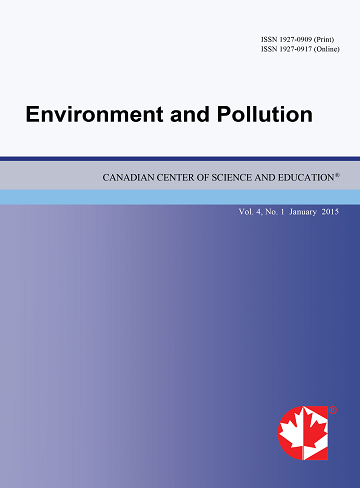Aliphatic Hydrocarbons in Recent Dated Sediment Cores of Imo River, SE Nigeria: Environmental/Historical Implications
- Inyang O. Oyo-Ita
- Unyime U. Umoh
- Ugim S. Ugim
- Emmanuella E. Oyo-Ita
- Orok E. Oyo-Ita
Abstract
Four recent sediment cores (0-30 cm long) from Afam (AF), Mangrove (MG), Estuary (ES) and illegal Petroleum refinery (PT) sites of the Imo River, Southeastern Nigeria were analyzed to characterize the sources and distribution of organic matter (OM), as well as examine their historical trends of deposition and assess human-induced changes in the last ca. 5 decades using biomarker approach. Radionuclides 210Pb and 137Cs were used to assign approximate dates to each section of the cores. Evaluation of proxy parameters such as carbon preference index (CPI, 2.01 - 2.19), carbon number maximum (Cmax, 29, 31) and atomic C/N (16.51-31.32) for the most recent top layers (0-5 cm) revealed greater wash-in of land-derived organic matter (OM), attributable to the recent rise in water height. The bottom layer (PT1, 25-30 cm,) of the PT core deposited ca. 1964-1972 exhibited a CPI of 0.97 and pristane/phytane (Pr/Ph, 3.75), suggesting that oil bunkering/illegal refinery activity had begun in the region ca. 8 years after the first commercial discovery of oil in Nigeria in 1956. The occurrence in high abundance of heptadecane in the middle layer (ES4, 10-15 cm) of the ES almost corresponded with the period of eutrophication that blocked the waterway in the late 1980s. Measurement of a marked unresolved complex mixture at the near-top layer (AF5, 5-10 cm) of the AF indicated that the heaviest contamination by petroleum hydrocarbons occurred at ca. 1997-2005. This time frame coincided with the period of intensive bunkering and oil pipeline vandalism by Niger Delta militant groups.
- Full Text:
 PDF
PDF
- DOI:10.5539/ep.v9n1p26
Journal Metrics
Index
- Academic Journals Database
- Berkeley Library
- CAB Abstracts
- CAS (American Chemical Society)
- CNKI Scholar
- COPAC
- CrossRef
- DTU Library
- Elektronische Zeitschriftenbibliothek (EZB)
- EuroPub Database
- Excellence in Research for Australia (ERA)
- Genamics JournalSeek
- Google Scholar
- Harvard Library
- Infotrieve
- Jisc Library Hub Discover
- JournalGuide
- JournalTOCs
- LOCKSS
- Max Planck Institutes
- Mir@bel
- PKP Open Archives Harvester
- Pollution Abstracts
- Publons
- Pubmed journal list
- ROAD
- Scilit
- SHERPA/RoMEO
- Standard Periodical Directory
- Stanford Libraries
- UCR Library
- Ulrich's
- UniCat
- Universe Digital Library
- UoS Library
- WorldCat
- Zeitschriften Daten Bank (ZDB)
Contact
- Albert JohnEditorial Assistant
- ep@ccsenet.org
